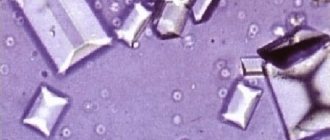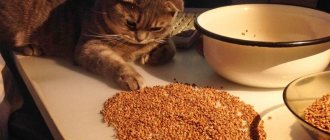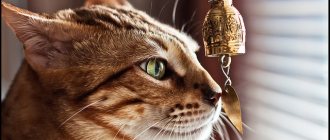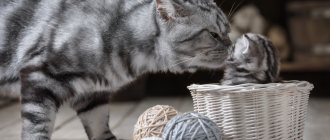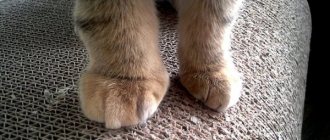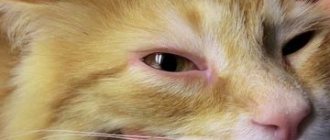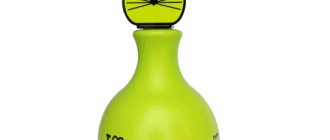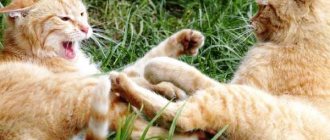Even people who have never had pets know very well that a cool, moist nose is an indicator of the health of the animal. The desire of cat owners to understand whether they should be concerned if the olfactory organ is warm and dry is understandable. Many diseases are accompanied by an increase in body temperature, at which this phenomenon occurs. But even a completely healthy cat can have a dry and warm nose. You need to be able to distinguish the symptoms of the disease from natural, safe changes in the temperature of the olfactory organ. This will help you take effective measures in a timely manner and avoid unnecessary concerns.
What kind of nose does a healthy cat have?
- What kind of nose does a healthy cat have? The nose of a pet that is absolutely healthy is always warm and slightly moist. Such signs are considered completely normal. But there are certain points that you should be aware of.
- Many cat breeds, for example, the Bengal cat , have a constantly dry nose. This is inherent in their nature. It is a dry nose that indicates that the animal is absolutely healthy.
- The Persian cat's nose, on the contrary, is always quite wet. This is because this breed has a slightly flattened muzzle and after the cat finishes washing itself, its nose remains wet.
- The humidity of the nose is often influenced by what exactly the pet eats. Many people claim that cats that eat only dry food have a moister nose than cats that eat natural food. This is because when eating dry food, animals need a large volume of water, and therefore they regularly wet their nose, when they drink water, they lick their lips.
Healthy nose
- A healthy cat, who is constantly active, has a normal psychological state, his nose is not very hot, almost the same as the whole body. It is moisturized, always has the same color, the skin around the nose is elastic and has a uniform structure.
- A cat's nose may be dry and warm according to your opinion, according to your personal feelings. The fact is that the temperature of cats is a couple of degrees higher than that of humans. A wet nose may always seem cold to you, and a dry nose may always seem hot.
Possible causes of lethargy in healthy animals
Often there are reasons why a cat is lethargic, sleeps all the time and eats little, but it is better to understand each of them in order.
Stress
It is not uncommon for a cat to eat poorly and sleep a lot after a serious nervous shock.
Cats are very sensitive animals, so they have many causes of stress:
- travel by car;
- the arrival of a new family member or pet in the house;
- change of owner;
- repair or rearrangement of the house;
- visit to the veterinarian;
- change of place of residence by owners;
- lack of attention from the owner;
- pain;
- recent surgery;
- visit of guests;
- bathing and other hygiene procedures;
- changes in daily routine;
- the appearance of new and unusual objects in the house;
- first time on the street.
Usually cats cope with this situation quite well without medical help, but they really need the support of their beloved owner. However, in some particularly susceptible cats, stress lasts for quite a long time and can even be harmful to health.
The main physiological signs of nervous shock in a cat:
- urinary incontinence;
- rapid breathing;
- diarrhea or constipation;
- increased cleanliness (a cat can lick itself until bald spots appear on its fur and irritation on the skin);
- yawning too often;
- urinating in inappropriate places (the cat is marking its territory).
It is important! If, as a result of stress, the cat’s behavior does not return to normal for a long time, it is better to show the animal to a doctor. After all, nervous shocks can negatively affect his health and lead to the development of diabetes, skin diseases and disturbances in the functioning of the cardiovascular, digestive and genitourinary systems.
Change of feed
Often the cause of a lethargic state and refusal to eat is a change in diet (for example, switching from natural food to ready-made food and vice versa).
In this situation, you should return the cat to its previous food and treat it with some treat. Then the restoration of appetite and a cheerful state will occur very quickly.
Hot weather
Cats do not have sweat glands. They do not know how to cool themselves by opening their mouths, like dogs. Therefore, in the heat, to protect themselves from overheating, furry pets try to lie more in cool places. In addition, they begin to eat less so as not to waste energy on burning calories received with food.
Age
Over time, many owners begin to worry that their once active and nimble cat has become lethargic, eating almost nothing and lying around all the time. This is easy to explain: older cats no longer have as much energy for play; they sleep longer and more soundly than young animals.
If an elderly pet is lethargic, eats without appetite and sleeps a lot, but at the same time drinks water and has the above signs of a healthy cat, then there is no need to worry. However, an older cat should be regularly taken to the veterinarian for examinations to prevent the development of diseases.
Kittens spend almost 90% of the day sleeping until they reach two months of age. If the kitten is lethargic, plays little and eats poorly during periods of wakefulness, then the best solution is a trip to the veterinarian.
It is important! The maximum duration of healthy fasting for kittens is 1 day, for young cats and middle-aged pets – 3 days, and for “old people” – 2 days. If after this time the cat still does not start eating, you need to consult a doctor as soon as possible.
Pregnancy
In the early stages of pregnancy, many cats, like people, suffer from toxicosis. They become lethargic, try to move less and more carefully, sleep more and often refuse to feed.
If a cat was mated 3-4 weeks before this condition, then after another 5-6 weeks you can expect an addition to the cat family.
Why does my cat have a warm and dry nose?
Cats spend a lot of time awake. They eat, walk, clean their fur and paws, while their nose remains moist.
There are only two reasons why this happens:
- The cat wets its nose with saliva when it licks itself and washes itself.
- The cat secretes nasal glands. They help the animal to catch the odors of the environment and eliminate excess heat.
Normal condition – a healthy pet’s nose is not wet. It's just a little damp, cold, smooth. There are no crusts, purulent or bloody discharge on the nose.
If a cat has clear discharge, this is also not considered a dangerous sign. But your nose cannot be regularly wet.
Dry
There are several main reasons why a cat has a warm and dry nose:
- During sleep , a cat's nose is usually dry. After all, the pet does not lick itself, and therefore saliva does not reach the olfactory organ, and the secretions of glandular cells do not protrude. The nose remains dry and warm for 30-60 minutes until the animal awakens.
- The cat may be near a heat source , for example, it could be a fireplace, a radiator, or a heater. Here everything is very clear - the nose becomes dry due to the device that people connected in order to increase the temperature in the room.
- Mild, non-prolonged discomfort. The disease can be minor, for example, the cat overate, ate hair when it was licked and it got into the stomach. If your cat is a little unwell, then her nose sometimes becomes dry.
- Active movements, games. Due to rapid movement, your pet's body temperature may become higher. Consequently, the nose dries out and becomes warmer.
- In small kittens, thermoregulation has not yet fully adjusted. In addition, the temperature in small animals is usually higher than in adults. This is why an animal's nose sometimes becomes dry, regardless of the time of day.
- If it is hot enough in the house or outside and stuffy, the pet’s nose quickly dries out. And it begins to moisturize after the cat finds itself in normal conditions.
- Stressful state. A cat's nose is dry and warm due to severe fright, during pregnancy, childbirth, and so on.
- Professional cat breeders claim that wet noses in old cats are a rare phenomenon. This happens because over time, the pet’s metabolism may slow down, and the cat itself becomes less active. As in all of these cases, this phenomenon, as a rule, is not considered a pathology.
Why is it dry and warm
? So, we were able to find out why a cat’s nose becomes dry. But he can remain in this state for only a short time. Now let's find out when to worry if your animal's nose has been dry for a very long time.
What to do if your cat has a dry nose?
Hyperthermia is the main ailment in cats, leading to a dry nose. Observe your pet for 2-3 hours: how and how much she eats, whether she goes to the toilet, whether she is playful or apathetic, etc.
Be sure to read:
The cat eats poorly and constantly sleeps, is lethargic: normal or pathological, the reason, what to do when you need help
If the animal's lethargy does not go away, contact your veterinarian. Also, do not delay a visit to the doctor if the cat does not allow you to touch its stomach, breaks out, scratches, or yellow-green bubbles are periodically visible from its nose.
You can make your cat feel a little better by periodically applying something cool to her armpits and groin area. Also wet your pet's fur - this will slightly lower the body temperature. Do not diagnose your cat - this can only be done by a specialist.
Wait for the doctor, and while he is on his way to you, stay close to your pet. Talk kindly, stroke her head - she needs support.
A cat has a dry and warm nose: when is this a sign of illness?
Sometimes a cat has a dry and warm nose - this is a harbinger of a serious illness. Sometimes the illness turns out to be very serious. The nose becomes dry in the following cases:
- Gastrointestinal disorders. A cat can be poisoned by stale, bad food, this can happen after taking antibiotics. In this case, the cat’s nose becomes dry, its body temperature increases, and the cat may be accompanied by vomiting, loose stools, and weakness. The pet may refuse food altogether.
- Infectious, viral, bacterial disease. In addition to the fact that your pet's nose may become dry, his body temperature may increase, he may be bothered by a fever, and have loose stools. The cat may sneeze, refuse food or water.
- Diseases caused by ticks . The cat often begins to scratch his ears and muzzle, shake his head, behave restlessly, and refuse to eat. In this case, as a rule, the animal’s skin becomes inflamed, thickens, the skin in the head area becomes bald, its temperature rises, and its nose becomes dry.
- Cold - the cat's ears become hot, his nose becomes dry and cool. Body temperature increases, the animal weakens.
Maybe due to workload
- Note that a dry spout almost always has the same temperature - minimum +39.5°C and maximum +40°C. What can cause hyperthermia? There can be quite a few reasons: the presence of cancer, failures in the functionality of certain organs.
- The nose may become dry if the cat has worms, which poison the animal's body. In addition, there are cases when a cat suddenly develops a fever, but he still feels healthy.
- To help you understand whether your cat is sick or completely healthy, check his nose for moisture. Be sure to pay attention to what temperature your pet’s nose is and what condition it is in. Is the cat bothered by vomiting, diarrhea, does the animal refuse to eat, does it have discharge from its eyes, nose, and so on. If your animal’s nose is constantly dry, or other alarming symptoms arise, then immediately take your pet to the veterinary clinic.
- If your pet's nose is even hot (you feel this at the first touch), and the animal itself looks weak, this is very serious. The kitten's temperature may rise significantly. Don't wait, take your pet to the doctor immediately.
Disease
A similar thing occurs in domestic animals during a viral infection. And such diseases, as a rule, can be dangerous and lead to death. To avoid this, you should do the following:
- Place the cat in a room that is well ventilated. Just make sure there are no drafts. The ideal room temperature in this case is +20°C.
- Give your pet plenty of water. You can add a little sugar to it.
- Call your veterinarian.
How does the condition manifest?
In cats, periods of increased activity are usually followed by apathy and drowsiness. It is difficult for owners to understand why and at what exact moments this happens. Therefore, a situation where a cat is lethargic, hardly eats and sleeps a lot, is alarming.
The owner should clearly know that poor appetite and less active behavior do not always indicate an illness in the animal. And the veterinarian is sometimes unable to understand why the cat is lethargic. The observations of an attentive and loving owner are extremely important here.
The main signs of cat health, in addition to good appetite and good spirits, are:
- shiny and smooth coat;
- pink and slightly moistened mucous membranes;
- cold and slightly damp nose (normally, during sleep it can become warm and dry);
- pulse, respiratory rate and temperature are within normal limits;
- absence of excessive discharge from the eyes, ears and nose, plaque in the mouth, salivation and unpleasant odor from the mouth and ears.
It is important! The normal duration of rest for a cat per day is 12-14 hours or more.
The cat has a cold and dry nose: what to do?
When a cat's nose is cold and dry, this is also a bad sign. This may happen for the following reasons:
- The cat has severe intoxication, regardless of its origin.
- During sepsis.
- If your pet is experiencing the thermal stage of some infectious disease.
- During intermittent fever. In this case, the animal’s temperature can periodically rise and then decrease.
- In each case, the nose becomes cold, as does the body of the animal. Most often, an unexpected drop in body temperature indicates that the animal’s brain does not have time to respond to thermoregulation.
Cold
- Sometimes this condition leads to the death of the pet. Immediately place the cat in a warm room (just make sure the room is not too hot), and call a veterinarian immediately. Self-treatment in such a situation can lead to big problems.
Warm, dry nose as a symptom of the disease
Increased nasal temperature and dryness that occur due to natural causes do not persist for a long time. Quite quickly the organ of smell returns to its normal state. If the signs do not go away, you need to carefully monitor your pet. The disease usually causes several symptoms. Along with an increase in temperature, the following symptoms may appear:
- lethargy, apathy, lack of appetite;
- long, uninterrupted sleep;
- heart rhythm disturbance, tachycardia;
- strong thirst;
- slow breathing;
- sneezing, mucus discharge from the nose;
- nausea, vomiting, diarrhea;
- anxiety, restlessness;
- knocked down, dull, disheveled wool, etc.
If these symptoms appear, the cat must be shown to a veterinarian, the cause of the ailment must be determined, and effective treatment must be started immediately.
You need to pay attention not only to the temperature and dryness of the nose, but also to its color. If it is warm and pale, there are disturbances in the functions of the circulatory system and hematopoiesis. A bright pink color may indicate the presence of infection; a bluish, purple tint appears with oxygen deficiency, inflammatory processes in the lungs, or poisoning. Liver failure leads to yellowing of the olfactory organ.
The cat has a dry and warm nose: what to do at home?
If your cat feels fine and nothing serious has happened to him, you can help your pet yourself. We offer you special measures that will be useful to you if your cat has a dry and warm nose.
- The cat's nose is dry and dirty. If you don’t clean your cat’s nose, it can become dirty, after which it will be difficult for the pet to breathe and the physiological lubrication of the nose will decrease. As a result, thermoregulation will be disrupted and the nose will be hot.
- Carefully clean the dirty spout from the outside and inside. Be careful not to damage sensitive tissue. After approximately 20 min. you will notice that your cat's condition returns to normal.
- Burn from strong sun rays. Every cat loves to sleep in the sun. But prolonged sleep under strong rays of the sun does not bring any benefit. Situations with burns are much more common than expected. This is especially true for those individuals who have a delicate pink nose.
- In a cat that has received a sunburn, the nose becomes red, hot, and the pet feels pain at the slightest touch. Over time, the skin on the nose becomes rougher, it becomes dry and rough. In this case, treat the cat’s nose with an anti-burn drug that has moisturizing and anti-inflammatory properties. Apply the product carefully so that it does not penetrate the nostrils. Repeat the procedure again until the nose looks normal.
Treat your nose
- Allergic reaction to chemicals. Many pets can have allergies. Don't forget about this when cleaning the house. If you do not wash the product well, it can cause great harm to the cat, who likes to poke his own nose into every corner.
- Urgently carry out another wet cleaning. Wash all surfaces thoroughly with clean water. Wash away any remaining chemicals that may cause irritation or allergies in your cat. Also does not include consultation with a veterinarian. He will tell you which antihistamine can be given to your pet and in what dose.
Lethargic pet
INTERESTING! A dangerous symptom of a dry nose and hot ears is the animal’s inactivity, the pet sleeps a lot, and lack of appetite.
Dilated pupils in a pet along with an increase in temperature are a serious signal of illness. This disease may cause symptoms such as vomiting, diarrhea, hair loss, and animal anxiety. If your pet is lethargic:
- Provide the cat with a dry and warm place.
- Heat the milk and give your pet a drink.
- It is recommended to massage the animal's abdomen and stroke it all over the body, this is required for better blood flow in the superficial skin vessels.
- It is necessary to check the pet's pulse; when the animal is over, the pulse will be rapid. The animal may also sneeze, breathe deeply, and possibly cough.
The kitten has a dry and warm nose: what to do?
- The body of a small kitten is very similar to that of a child. He also has a high metabolism. A pet's nose can react to various changes much faster than that of an adult cat.
- And thermoregulation at a young age is still unstable; it has not yet fully formed.
- During the course of a day, your kitten’s nose may become cold, then hot, dry, or wet several times.
This may depend on all sorts of factors:
- The kitten just woke up.
- The pet started playing.
- The baby has recently eaten.
In a kitten
The condition of the nose may also depend on what mood the kitten is in.
- Such changes are considered natural, so you should not worry about such an event. But, if the animal shows alarming signs (the mood, behavior has changed, the kitten has become less active), it is necessary to sound the alarm.
- Kittens have dry and warm noses unless their mother licks them thoroughly. The kids themselves cannot do this on their own. In such a situation, help the growing animal. Wipe the kitten's face with warm water several times a day, but it must be boiled.
- The condition of a small kitten's nose can tell you a lot. But his risk of getting sick is much greater if you have not yet had time to vaccinate him. In addition, a dry, hot nose may indicate that the pet has been poisoned. In this case, go to the vet immediately.
Watch the nose
Try to pay close attention to such physiological changes in cats. As a rule, they do not signal any serious illness. But there are cases that a dry nose is only the first symptom of a serious illness, and therefore you cannot do without the help of a veterinarian.
cat nose
The nose is a cat's important olfactory organ. As a rule, its color matches the general color of the animal. True, there are exceptions. The interesting thing is that depending on the color and temperature, the color of the nose can change. For example, when it gets colder, some individuals’ noses become lighter, while others’ noses become darker. Healthier noses are found in individuals with a normal head and muzzle shape. But owners of flattened faces often suffer from diseases of the respiratory system. This is due to the fact that the nasal cartilage is flattened. And this prevents the nose from functioning normally.
In addition to the olfactory function, the animal’s nose also performs others:
- By looking at their nose, you can roughly understand what temperature a cat has: normal or elevated.
- Protective. The air passing through the nasal passages is cleansed of harmful microorganisms and dust and warms up.
- The skin on a cat's nose is very sensitive to temperature. Thanks to this, your pet can easily determine whether the food in front of her is hot or cold, without even touching the food.
- Representatives of the cat family often lick their nose, and the mucous membrane constantly produces special secretions. This is why cats have wet and cool noses.
Natural causes of baby's dry nose
As already mentioned, this condition is not always a cause for concern. It is worth highlighting a number of natural reasons that can lead to such changes.
Animal's recent sleep
Animals almost always have a dry nose after waking up. This is due to the fact that the kitten does not lick itself while sleeping, the secretion is not produced, and the lobe is not moistened.
After a short period, the organ becomes cool and moist again. There is no reason to worry in this case.
High indoor or outdoor temperature
Dryness is often observed during hot weather, with a lack of fresh air.
For example, if a kitten rested in the sun or a radiator, its nose will inevitably heat up. After a while, everything returns to normal on its own.
Stress in an animal
Insufficient moisture in the earlobe is often caused by stress.
The following seemingly minor factors can lead to such changes:
absence of the owner for a long time;- strangers coming to the house;
- the appearance of a new animal in the apartment;
- moving;
- visiting a veterinary clinic;
- carrying out hygiene procedures.
After an active game
If a cat has been jumping, running, or playing for a long time, its nose dries out due to a natural increase in body temperature. When he rests, everything will return to normal.
Old age of the animal
At an early and old age, cats experience a disturbance in the process of thermoregulation.
Accordingly, the mirror may become dry. Such changes also do not cause concern. They are considered a variant of the norm.
A cat's nose as an indicator of well-being
The main function of a cat's nose is olfactory. Thanks to numerous (almost 20 times more than in humans) receptors, it helps completely blind kittens to freely navigate in space from birth. Babies deprived of sight and hearing always find their mother by reacting to surrounding smells.
The nasal sinuses are separated by a cartilaginous septum, and immediately behind them are the ethmoidal conchae. All odors entering this section are transmitted by receptors directly to the brain, which identifies the sniffed object or subject. The nasal bones of flat-faced breeds are deformed, making it more difficult for them to recognize odors and have a harder time breathing.
In addition to the olfactory, it is important to note the protective and tactile functions. The inhaled air is filtered inside the sinuses to remove dust and microorganisms and warms up to a comfortable temperature. The tactile function is performed by the lobe. This is what cats use to determine the temperature of food.
For the owner of a mustachioed pet, the latest function remains important, allowing you to assess your well-being without undergoing tests. If the animal is healthy, then its lobe:
- a little shiny;
- cool;
- wet;
- has no crusts or scales.
Humidity is achieved thanks to a special secretion secreted by the mucous membranes. It creates a protective film that protects the cat from the adverse effects of external factors, and helps to retain molecules of foreign substances to recognize their odors. Also, the wetness of the nose is associated with frequent licking, characteristic of the cat family.
